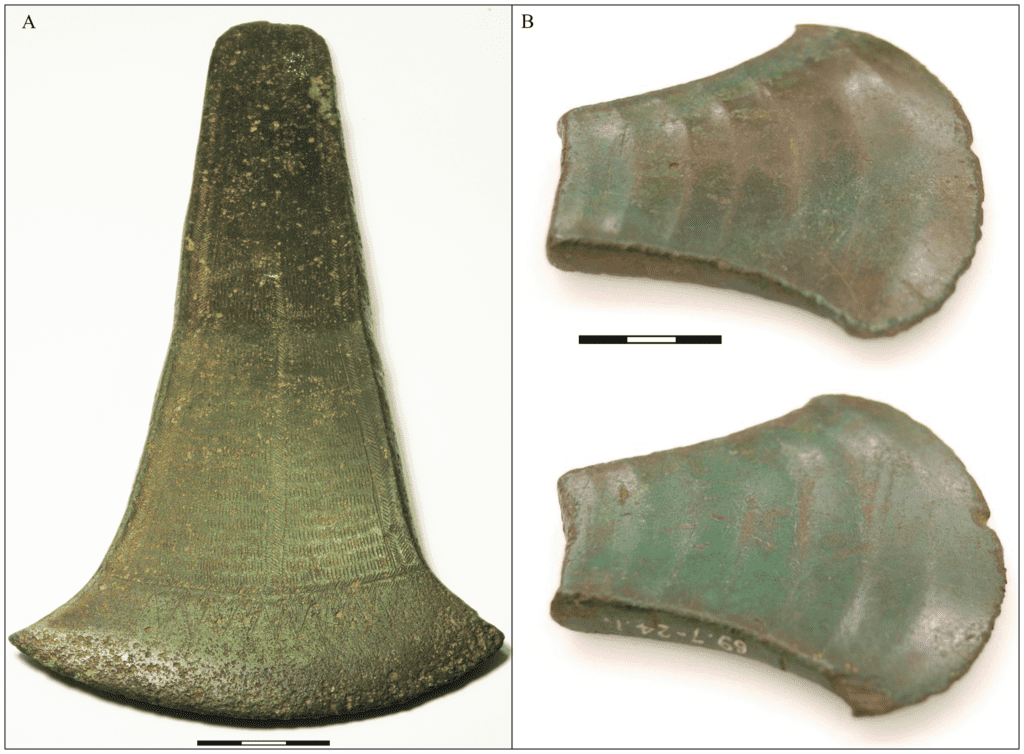The forefathers of Vikings build their axes with imported metal.

Image credits Heide W. Nørgaard, Ernst Pernicka, Helle Vandkilde, 2019, PLOS One.
The geographic origins of the metals used in Scandinavian mixed-metal (bronze) artifacts can be traced back to Britain and continental Europe, a new study reports. Based on the findings, the authors from Aarhus University, Denmark, estimate that Scandinavia was “dependent” on imported tin and copper at the beginning of the Nordic Bronze Age.
Shipping Bronze
“4000 years ago, Britain and Central Europe supplied copper and tin to Denmark, which has no metal sources of its own,” the authors write. “Instead finished metal objects were imported and recast to fit local tastes. In this creative process at the onset of the rich Nordic Bronze Age mixing of the original sources took place. This conclusion is prompted by robust archaeological and geo-chemical data.”
The earliest signs of bronze-type alloys being used in Scandinavia (known as Nordic Bronze age) hail from around 2000-1700BC. Around this time, both tin and copper (which mix to make bronze) had rapidly, and drastically, increased in availability in the area. In a bid to understand where this metal came from, Heide W. Nørgaard from Aarhus University, Denmark, and colleagues performed isotope and trace-element analyses on 210 Bronze Age artifact samples (mostly axe heads) collected in Denmark. The majority of samples (141 counts) date between 2000–1700 BC and 50 samples from 1700–1600 BC.
The sample size represents around 50% of all known Danish metal objects from the early Nordic Bronze age, the team explains.
Trade was how the early Danes got their metal, the findings suggest. Robust trading networks were established to import raw metal and finished metal goods such as tools and weapons via two major routes: one leading down across the Baltic Sea towards the Únĕtice (a Bronze Age civilization in what is now eastern Germany and Bohemia), and another leading west to the British Isles.
These two sources made up a sizeable portion of the Scandinavian bronze ‘market’ at the time, the team explains. This is underscored by findings of particular isotopic signatures and the particular make-up of the alloys, which allowed the team to track their origins. Artifacts from between 2000–1700 BC are mainly made from high-impurity copper (fahlore type copper), except those imported from the British isles. Local production was based on the re-casting of foreign items, the team explains, as suggested by the presence of this British copper in axes of local styles. The team also reports finding lower lead contents in locally-crafted items than in imported ones, which suggests locals were mixing copper from different sources.
Later, around 1800–1700 BC, the team reports that a new and distinct type of copper with low impurity levels starts coming to the forefront. Copper from Slovakia was widely-used in Scandinavia during this time, with the Úntice people likely acting as middlemen facilitating the trade.
Metal recycling remained common in Scandinavia, with smiths here repeatedly re-casting imported objects into goods of local styles. The authors also found evidence of relatively pure copper sourced from the eastern Alps that would become dominant in Scandinavian smithing later in the Bronze Age.
The findings showcase how important trade was even for communities that we’d consider ‘primitive’. They also align with previous findings of copper trade networks dating from the time of Otzi the Iceman, stone-age Vietnam, and Ancient Babylon, showcasing how important this metal was at its time — and the efforts people were willing to go through to trade in it.
The paper “On the trail of Scandinavia’s early metallurgy: Provenance, transfer and mixing” has been published in the journal PLOS One.


